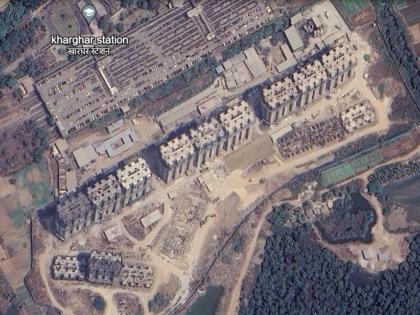Navi Mumbai: Centre Directs Maharashtra Govt to Probe Environmental Violations in PMAY Project by CIDCO
By Amit Srivastava | Updated: September 2, 2024 09:55 IST2024-09-02T09:33:53+5:302024-09-02T09:55:43+5:30
The Centre has directed the Maharashtra Government to investigate alleged environmental violations in executing Prime Minister Awas Yojana (PMAY) ...

Satellite image of PMYA project in Kharghar
The Centre has directed the Maharashtra Government to investigate alleged environmental violations in executing Prime Minister Awas Yojana (PMAY) by the State-owned City and Industrial Development Corporation (CIDCO) in Navi Mumbai.
This directive follows a complaint by the environmental watchdog, NatConnect Foundation, to the Prime Minister, highlighting that construction activities are occurring alarmingly close to mangroves and the Panvel Creek, ignoring global concerns over rising sea levels.
NatConnect Foundation raised concerns that the Kharghar project, which will house 10,000 residents and numerous small businesses, could face a permanent threat from tidal wave attacks. The Centre for Study of Science, Technology and Policy (CSTEP) reports that 10% of Mumbai will go under the sea by 2040.
“At a time when we should be focusing on disaster mitigation measures, we are building multi-storeyed residential and commercial complexes near the sea,” said NatConnect director B N Kumar. He criticized the town planners for failing to learn from past incidents of unseasonal floods and monsoon-related havoc, especially along coastal areas.
CIDCO has confirmed plans to construct 17 towers in Kharghar alone. Kumar referred to this as an "invitation to disaster."
Kumar submitted his complaint via the PM Office Public Grievances (PMOPG) website. In response, the Union Ministry of Environment, Forest, and Climate Change (MOEFCC) has asked the Maharashtra Coastal Zone Management Authority (MCZMA) to examine the issue and report back.
MOEFCC's letter, signed by Scintist Dr. Raghavan P, from the CRZ section, emphasized that States and Union Territories are responsible for enforcing Coastal Regulation Zone provisions under the Environment Protection Act of 1986. Dr. Raghavan instructed the MCZMA's member secretary to assess the severity of the "serious violations" in the PMAY's execution in Navi Mumbai.
NatConnect's complaint highlighted that PMAY projects, especially in the Mansarovar and Kharghar areas, are being developed near sensitive ecosystems like mangroves, mudflats, and inter-tidal wetlands. The NGO, using Google Earth maps, noted that the compound wall of the Kharghar project on the northern side of the railway station is alarmingly close to mangroves, with a distance ranging from just 8 to 25 meters.
“This violates both central and state project clearances,” NatConnect stated. The Environmental Clearance (EC) summary clearly stipulates that no mangroves should be affected during construction and that a 50-meter buffer zone must be maintained. Additionally, thick vegetation of tall trees should be planted along the buffer zone to mitigate dust emissions towards the mangrove area.
Minutes from the 143rd meeting of the Maharashtra Coastal Zone Management Authority, held on February 4, 2020, noted that the projects fall partially under CRZ1, prohibiting CIDCO from constructing within the 50-meter mangrove buffer zone and mandating a 100-meter CRZ setback from the creek.
However, Kharghar-based activist Joyoti Nadkarni expressed concern that the PMAY buildings are creeping into the danger zone. She warned that the compound wall could push the high tide line closer to Panvel Creek, potentially causing flooding in other areas as water naturally finds its path, disregarding CIDCO's boundaries.
Nadkarni also pointed out that the environmental clearances were granted only after visits from the state mangrove cell, under the condition that mangrove zones remain unaffected. She emphasized that taxpayers' money, used as subsidies for the PMAY project, should not fund initiatives that harm the environment.
Open in app